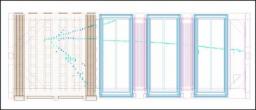In Japan at the end of January 2010, the detectors of the Tokai to Superkamiokande (T2K, [ti:tu:kei]), developed at Saclay, observed their first neutrinos. These detectors consist of two large chambers where the tracks of charged particles are able to be reconstructed and the neutrino beam can be characterized. In this experiment, neutrinos are created by a proton beam coming from the Tokai accelerator. These same neutrinos are then measured 300 km away, at Kamioka, in a large water vessel 40 m in diameter and 40 m high, which was previously used to study neutrinos coming from cosmic ray interactions in the atmosphere and to definitively prove the phenomena of neutrino oscillation (leading to a Nobel Prize for Masatoshi Koshiba in 2002). The first interaction with a neutrino coming from Tokai was observed at the end of February in the detector at Kamioka, marking the beginning of a very exciting new phase in neutrino physics.
Observation of the effects of an interaction of a neutrino from the beam in the near detector at T2K. Trajectories can be distinguished for the charged particles produced in the target and detected in the three TPC, indicated by the volumes outlined in blue.
• The ultimate constituents of matter › Neutrino Physics
• Institute of Research into the Fundamental Laws of the Universe • The Electronics, Detectors and Computing Division • The Particle Physics Division • The Systems Engineering Division
• T2K



